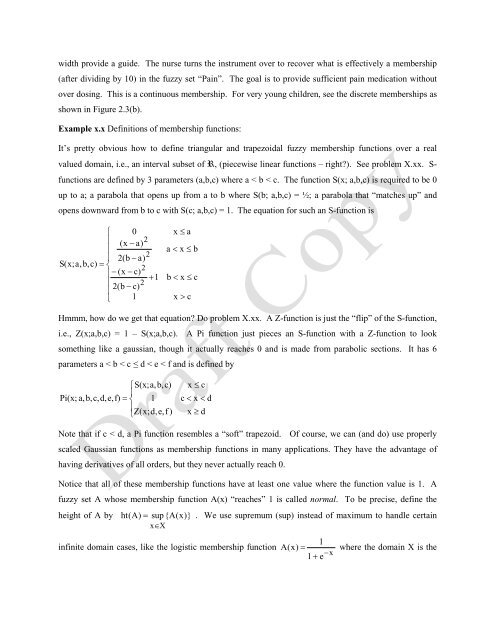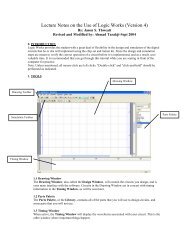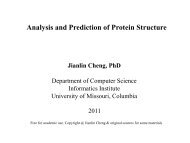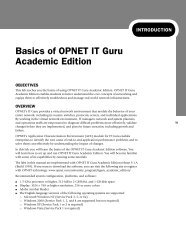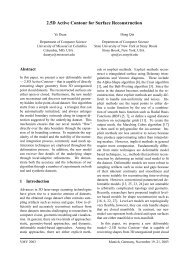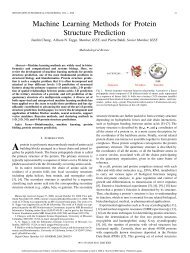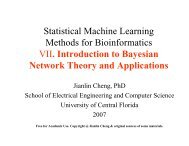Chapter X: Introduction to Fuzzy Set Theory Uncertainty is universal ...
Chapter X: Introduction to Fuzzy Set Theory Uncertainty is universal ...
Chapter X: Introduction to Fuzzy Set Theory Uncertainty is universal ...
Create successful ePaper yourself
Turn your PDF publications into a flip-book with our unique Google optimized e-Paper software.
width provide a guide. The nurse turns the instrument over <strong>to</strong> recover what <strong>is</strong> effectively a membership<br />
(after dividing by 10) in the fuzzy set “Pain”. The goal <strong>is</strong> <strong>to</strong> provide sufficient pain medication without<br />
over dosing. Th<strong>is</strong> <strong>is</strong> a continuous membership. For very young children, see the d<strong>is</strong>crete memberships as<br />
shown in Figure 2.3(b).<br />
Example x.x Definitions of membership functions:<br />
It’s pretty obvious how <strong>to</strong> define triangular and trapezoidal fuzzy membership functions over a real<br />
valued domain, i.e., an interval subset of R, (piecew<strong>is</strong>e linear functions – right?). See problem X.xx. S-<br />
functions are defined by 3 parameters (a,b,c) where a < b < c. The function S(x; a,b,c) <strong>is</strong> required <strong>to</strong> be 0<br />
up <strong>to</strong> a; a parabola that opens up from a <strong>to</strong> b where S(b; a,b,c) = ½; a parabola that “matches up” and<br />
opens downward from b <strong>to</strong> c with S(c; a,b,c) = 1. The equation for such an S-function <strong>is</strong><br />
⎧ 0<br />
⎪ (x − a)<br />
2<br />
⎪<br />
⎪ 2(b − a)<br />
2<br />
S(x;a,b,c) = ⎨<br />
⎪−<br />
(x − c)<br />
2<br />
+ 1<br />
⎪<br />
⎪<br />
2(b − c)<br />
2<br />
⎩ 1<br />
x ≤ a<br />
a < x ≤ b<br />
b < x ≤ c<br />
x > c<br />
Hmmm, how do we get that equation? Do problem X.xx. A Z-function <strong>is</strong> just the “flip” of the S-function,<br />
i.e., Z(x;a,b,c) = 1 – S(x;a,b,c). A Pi function just pieces an S-function with a Z-function <strong>to</strong> look<br />
something like a gaussian, though it actually reaches 0 and <strong>is</strong> made from parabolic sections. It has 6<br />
parameters a < b < c ≤ d < e < f and <strong>is</strong> defined by<br />
Pi(x; a,b,c,d,e,f)<br />
⎧S(x;a,b,c)<br />
⎪<br />
= ⎨ 1<br />
⎪<br />
⎩Z(x;d,e,f )<br />
x ≤ c<br />
c < x < d<br />
x ≥ d<br />
Note that if c < d, a Pi function resembles a “soft” trapezoid. Of course, we can (and do) use properly<br />
scaled Gaussian functions as membership functions in many applications. They have the advantage of<br />
having derivatives of all orders, but they never actually reach 0.<br />
Notice that all of these membership functions have at least one value where the function value <strong>is</strong> 1. A<br />
fuzzy set A whose membership function A(x) “reaches” 1 <strong>is</strong> called normal. To be prec<strong>is</strong>e, define the<br />
height of A by ht(A) = sup {A(x)}<br />
. We use supremum (sup) instead of maximum <strong>to</strong> handle certain<br />
x∈X<br />
1<br />
infinite domain cases, like the log<strong>is</strong>tic membership function A(x) = 1 + e<br />
−x<br />
where the domain X <strong>is</strong> the


